Multiscale Geophysical Characterization of Leachate and Gas Plumes in a Tropical Landfill Using Electrical Resistivity Tomography for Environmental Analysis and Diagnosis
Abstract
1. Introduction
2. Materials and Methods
2.1. Study Area Location
2.2. ERT Survey Design and Line Deployment
2.3. Operational Principles and Data Acquisition
- Wenner—High vertical sensitivity
- Dipole–Dipole—High lateral resolution
- Gradient—Rapid acquisition and uniform coverage
2.4. Processing, Inversion, and Modeling
2.5. Experimental Support and Statistical Analysis
2.6. Spatial Integration and Visualization of Resistivity Models
2.7. Resistivity Interpretation Criteria
2.8. Volumetric Estimation of Gas from Resistivity Anomalies
3. Results
3.1. Interpretation of Geophysical Models
3.1.1. Wenner Array Results
3.1.2. Dipole–Dipole Array Results
3.1.3. Gradient Array Results
3.1.4. Comparative Average Resistivity per Survey Line and Method
3.2. Spatial Analysis of Resistivity Distribution: Horizontal, Vertical, and Transverse Sections
3.2.1. Shallow Horizontal Section (0–5 m)
3.2.2. Representative Vertical Section
3.2.3. Transverse Section
3.2.4. D Volumetric Model
3.3. Volumetric Estimation of Gas Accumulations Based on Electrical Resistivity
4. Discussion
4.1. Implications of Geophysical Models in Landfill Characterization
4.1.1. Wenner Configuration
4.1.2. Dipole–Dipole Configuration
4.1.3. Gradient Configuration
4.1.4. Average Resistivity Distribution by Survey Line and Geophysical Method
4.2. Spatial Implications of Integrated Resistivity Models
4.2.1. Shallow Horizontal Patterns and Leachate Dynamics
4.2.2. Vertical Stratigraphy and Preferential Flow
4.2.3. Transverse Contrasts and Gas–Leachate Interactions
4.3. Insights from 3D Volumetric Modeling
4.4. Significance of Volumetric Gas Estimations
4.5. Environmental Diagnosis and Monitoring in Hydrogeological Risk Contexts
4.6. Study Limitations and Scope
5. Conclusions
Supplementary Materials
Author Contributions
Funding
Data Availability Statement
Acknowledgments
Conflicts of Interest
References
- Vaverková, M.D. Landfill Impacts on the Environment—Review. Geosciences 2019, 9, 431. [Google Scholar] [CrossRef]
- Chambers, J.E.; Wilkinson, P.B.; Meldrum, P.I.; Kuras, O.; Ford, J.R.; Gunn, D.A.; Ogilvy, R.D. Electrical Resistivity Tomography Applied to Geological, Hydrogeological and Engineering Investigations at a Former Waste-Disposal Site. Geophysics 2006, 71, B231–B239. [Google Scholar] [CrossRef]
- Lou, X.F.; Nair, J. The impact of landfilling and composting on greenhouse gas emissions—A review. Bioresour. Technol. 2009, 100, 3792–3798. [Google Scholar] [CrossRef] [PubMed]
- Christensen, T.H.; Kjeldsen, P.; Bjerg, P.L.; Jensen, D.L.; Christensen, J.B.; Baun, A.; Albrechtsen, H.-J.; Heron, G. Biogeochemistry of Landfill Leachate Plumes. Appl. Geochem. 2001, 16, 659–718. [Google Scholar] [CrossRef]
- Kjeldsen, P.; Barlaz, M.A.; Rooker, A.P.; Baun, A.; Ledin, A.; Christensen, T.H. Present and Long-Term Composition of MSW Landfill Leachate: A Review. Crit. Rev. Environ. Sci. Technol. 2002, 32, 297–336. [Google Scholar] [CrossRef]
- Grau, J.; Terraza, H.; Rodríguez Velosa, D.M.; Rihm, A.; Sturzenegger, G. Solid Waste Management in Latin America and the Caribbean; Inter-American Development Bank: Washington, DC, USA, 2015. [Google Scholar] [CrossRef]
- UNEP. Waste Management Outlook for Latin America and the Caribbean; UN Environment: Nairobi, Kenya, 2018. [Google Scholar]
- Bradley, M.W. Ground-Water Hydrology and the Effects of Vertical Leakage and Leachate Migration on Ground-Water Quality Near the Shelby County Landfill, Memphis, Tennessee; U.S. Geological Survey Water-Resources Investigations Report 1991; WRI 90–4075; U.S. Geological Survey (USGS): Reston, VA, USA, 1991. [Google Scholar]
- Rodriguez-Cárdenas, L.; Li, N.; Ramírez-Alegría, J.D. Leachate Pollution Index (LPI) in Sanitary Landfills: Indicators of Vertical and Lateral Migration Affecting Soil and Aquifer Systems. Molecules 2025, 30, 3325. [Google Scholar] [CrossRef]
- Mor, S.; Ravindra, K.; Dahiya, R.P.; Chandra, A. Leachate Characterization and Assessment of Groundwater Pollution near Municipal Solid Waste Landfill Site. Environ. Monit. Assess. 2006, 118, 435–456. [Google Scholar] [CrossRef]
- Alam, M.J.B.; Ahmed, A.; Alam, M.Z. Application of Electrical Resistivity Tomography in Geotechnical and Geoenvironmental Engineering Aspect. Geotechnics 2024, 4, 399–414. [Google Scholar] [CrossRef]
- Binley, A.; Hubbard, S.S.; Huisman, J.A.; Revil, A.; Robinson, D.A.; Singha, K.; Slater, L.D. The Emergence of Hydrogeophysics for Improved Understanding of Subsurface Processes over Multiple Scales. Water Resour. Res. 2015, 51, 3837–3866. [Google Scholar] [CrossRef]
- Dimech, A.; Cheng, L.Z.; Chouteau, M.; Chambers, J.; Uhlemann, S.; Wilkinson, P.; Meldrum, P.; Mary, B.; Fabien-Ouellet, G.; Isabelle, A. A Review on Applications of Time-Lapse Electrical Resistivity Tomography Over the Last 30 Years: Perspectives for Mining Waste Monitoring. Surv. Geophys. 2022, 43, 1699–1759. [Google Scholar] [CrossRef] [PubMed]
- Gourdol, L.; Clément, R.; Juilleret, J.; Pfister, L.; Hissler, C. Exploring the Regolith with Electrical Resistivity Tomography in Large-Scale Surveys: Electrode Spacing-Related Issues and Possibility. Hydrol. Earth Syst. Sci. 2021, 25, 1785–1812. [Google Scholar] [CrossRef]
- Imhoff, P.T.; Reinhart, D.R.; Englund, M.; Guérin, R.; Gawande, N.; Han, B.; Jonnalagadda, S.; Townsend, T.; Yazdani, R. Review of State of the Art Methods for Measuring Water in Landfills. Waste Manag. 2007, 27, 729–745. [Google Scholar] [CrossRef]
- Gawande, N.A.; Reinhart, D.R.; Thomas, P.A.; McCreanor, P.T.; Townsend, T.G. Municipal Solid Waste In Situ Moisture Content Measurement Using an Electrical Resistance Sensor. Waste Manag. 2003, 23, 667–674. [Google Scholar] [CrossRef]
- Maurya, P.K.; Rønde, V.K.; Fiandaca, G.; Balbarini, N.; Auken, E.; Bjerg, P.L.; Christiansen, A.V. Detailed landfill leachate plume mapping using 2D and 3D Electrical Resistivity Tomography—With correlation to ionic strength measured in screens. J. Appl. Geophys. 2017, 138, 1–8. [Google Scholar] [CrossRef]
- Helene, L.P.I.; Moreira, C.A.; Bovi, R.C. Identification of leachate infiltration and its flow pathway in landfill by means of Electrical Resistivity Tomography (ERT). Environ. Monit. Assess. 2020, 192, 249. [Google Scholar] [CrossRef] [PubMed]
- Orlando, L.; Marchesi, E. Georadar as a Tool to Identify and Characterise Solid Waste Dump Deposits. J. Appl. Geophys. 2001, 48, 163–174. [Google Scholar] [CrossRef]
- Porsani, J.L.; Malagutti Filho, W.; Elis, V.R.; Shimeles, F.; Dourado, J.C.; Moura, H.P. The Use of GPR and VES in Delineating a Contamination Plume in a Landfill Site: A Case Study in SE Brazil. J. Appl. Geophys. 2004, 55, 199–209. [Google Scholar] [CrossRef]
- Deidda, G.P.; De Carlo, L.; Caputo, M.C.; Cassiani, G. Frequency-domain electromagnetic induction imaging: An effective method to see inside a capped landfill. Waste Manag. 2022, 144, 29–40. [Google Scholar] [CrossRef]
- Bavusi, M.; Lapenna, V.; Rizzo, E. Electromagnetic methods to characterize the Savoia di Lucania waste dump (Southern Italy). Environ. Geol. 2006, 51, 301–308. [Google Scholar] [CrossRef]
- Darvasi, Y.; Agnon, A. Estimation of Low-Velocity Landfill Thickness with Multi-Method Seismic Surveys. Geotechnics 2023, 3, 731–743. [Google Scholar] [CrossRef]
- Martí, A.; Queralt, P.; Marcuello, A.; Ledo, J. Imaging leachate runoff from a landfill using magnetotellurics: The Garraf karst case. Sci. Total Environ. 2024, 920, 170827. [Google Scholar] [CrossRef]
- Martorana, R.; Capizzi, P.; Pirrera, C. Unconventional Arrays for 3D Electrical Resistivity and Induced Polarization Tomography to Detect Leachate Concentration in a Waste Landfill. Appl. Sci. 2023, 13, 7203. [Google Scholar] [CrossRef]
- Prezzi, C.; Orgeira, M.J.; Ostera, H.; Vásquez, C.A. Ground magnetic survey of a municipal solid waste landfill: Pilot study in Argentina. Environ. Geol. 2005, 47, 889–897. [Google Scholar] [CrossRef]
- Ciampi, P.; Giannini, L.M.; Cassiani, G.; Esposito, C.; Petrangeli Papini, M. Geo-constrained clustering of resistivity data revealing the heterogeneous lithological architectures and the distinctive geoelectrical signature of shallow deposits. Eng. Geol. 2024, 337, 107589. [Google Scholar] [CrossRef]
- Palacky, G. Resistivity Characteristics of Geologic Targets. In Electromagnetic Methods in Applied Geophysics—Theory; Nabighian, M.N., Ed.; Society of Exploration Geophysicists: Tulsa, OK, USA, 1987; Volume 1, pp. 53–129. [Google Scholar]
- Nobes, D.C. Troubled waters: Environmental applications of electrical and electromagnetic methods. Surv. Geophys. 1996, 17, 393–454. [Google Scholar] [CrossRef]
- Pomposiello, C.; Dapéna, C.; Boujón, P.; Favetto, A. Tomografías eléctricas en el basurero municipal de la ciudad de Gualeguaychú, provincia de Entre Ríos: Evidencias de contaminación. Rev. Asoc. Geol. Argent. 2009, 64, 603–614. [Google Scholar]
- Bichet, V.; Grisey, E.; Aleya, L. Spatial characterization of leachate plume using Electrical Resistivity Tomography in a landfill composed of old and new cells (Étueffont, France). Eng. Geol. 2016, 211, 61–73. [Google Scholar] [CrossRef]
- Wilkinson, P.B.; Chambers, J.E.; Meldrum, P.I.; Kuras, O.; Holyoake, S.J.; Ogilvy, R.D. High-resolution Electrical Resistivity Tomography monitoring of a tracer test in a confined aquifer. J. Appl. Geophys. 2010, 70, 268–276. [Google Scholar] [CrossRef]
- Zhan, L.-T.; Xu, H.; Jiang, X.-M.; Lan, J.-W.; Chen, Y.-M.; Zhang, Z.-Y. Use of electrical resistivity tomography for detecting the distribution of leachate and gas in a large-scale MSW landfill cell. Environ. Sci. Pollut. Res. Int. 2019, 26, 20325–20343. [Google Scholar] [CrossRef] [PubMed]
- Godio, A.; Chiampo, F. Geophysical Monitoring of Leachate Injection in Pretreated Waste Landfill. Appl. Sci. 2023, 13, 5661. [Google Scholar] [CrossRef]
- Ministry of Environment (Colombia). Technical Guidelines for Leachate Management in Sanitary Landfills; Ministry of Environment: Bogotá, Colombia, 2010.
- Griffiths, D.H.; Barker, R.D. Two-dimensional resistivity imaging and modelling in areas of complex geology. J. Appl. Geophys. 1993, 29, 211–226. [Google Scholar] [CrossRef]
- Dahlin, T.; Zhou, B. A numerical comparison of 2D resistivity imaging with ten electrode arrays. Geophys. Prospect. 2004, 52, 379–398. [Google Scholar] [CrossRef]
- Golden Software LLC. Grapher, Version 20.2; Golden Software LLC: Golden, CO, USA, 2023. Available online: https://www.goldensoftware.com/products/grapher (accessed on 1 October 2024).
- Loke, M.H. Tutorial: 2-D and 3-D Electrical Imaging Surveys; Geotomo Software: Penang, Malaysia, 2001; Available online: https://www.geotomosoft.com/downloads.php (accessed on 12 November 2024).
- Telford, W.M.; Geldart, L.P.; Sheriff, R.E. Applied Geophysics, 2nd ed.; Cambridge University Press: Cambridge, UK, 1990. [Google Scholar]
- Sharma, P.V. Environmental and Engineering Geophysics; Cambridge University Press: Cambridge, UK, 1997. [Google Scholar]
- Zhou, B.; Greenhalgh, S.A. Cross-hole resistivity tomography using different electrode configurations. Geophys. Prospect. 2000, 48, 887–912. [Google Scholar] [CrossRef]
- Morita, A.K.M.; Pelinson, N.S.; Bastianon, D.; Saraiva, F.A.; Wendland, E. Using Electrical Resistivity Tomography (ERT) to Assess the Effectiveness of Capping in Old Unlined Landfills. Pure Appl. Geophys. 2023, 180, 3599–3606. [Google Scholar] [CrossRef]
- Zaini, M.S.I.; Hasan, M. Application of Electrical Resistivity Tomography in Landfill Leachate Detection Assessment. In A Review of Landfill Leachate; Anouzla, A., Souabi, S., Eds.; Springer Water: Cham, Switzerland, 2024; Volume 1, pp. 1–22. [Google Scholar] [CrossRef]
- Servicio Geológico Colombiano (SGC). Geología de Colombia; Servicio Geológico Colombiano: Bogotá, Colombia, 2019; Volume 3. Available online: https://www2.sgc.gov.co/LibroGeologiaColombia/tgc/sgcpubesp37201911.pdf (accessed on 1 September 2025).
- Dajnov, V.N. Petróleo y Gas en Rocas. In Métodos Geofísicos; Editorial Reverté: Barcelona, Spain, 1982. [Google Scholar]
- Lu, Y.; Xie, Q.; Cao, C.; Huang, J.; Wang, J.; Ren, B.; Liu, Y. Detection of landfill leachate leakage around a valley-type landfill and its pollution and risk on groundwater. Water 2023, 15, 1778. [Google Scholar] [CrossRef]
- Alao, J.O.; Otorkpa, O.J.; Abubakar, F.; Eshimiakhe, D.; Aliyu, A.; Abdulsalami, M.; Abdulmalik, D.O. Geoelectrical Resistivity and Geochemistry Monitoring of Landfill Leachate Due to the Seasonal Variations and the Implications on Groundwater Systems and Public Health. Sci. Rep. 2024, 14, 26542. [Google Scholar] [CrossRef] [PubMed]
- Ibraheem, I.M.; Yogeshwar, P.; Bergers, R.; Tezkan, B. Joint interpretation of magnetic, transient electromagnetic, and electric resistivity tomography data for landfill characterization and contamination detection. Sci. Rep. 2024, 14, 30616. [Google Scholar] [CrossRef] [PubMed]
- Juliao, C.; Díaz, J.; Bermúdez, Y.; Aldana, M. Integration of Geoelectric and Geochemical Data Using Self Organizing Maps (SOM) to Characterize a Landfill. arXiv 2023, arXiv:2309.09164. [Google Scholar] [CrossRef]
- Trujillo-Romero, O.E.; Restrepo, G.M. From Prediction to Remediation: Characterization of Tropical Landfill Leachate Using ARIMA and Application of Adsorption and Reverse Osmosis Treat-ments. Sustainability 2025, 17, 5985. [Google Scholar] [CrossRef]

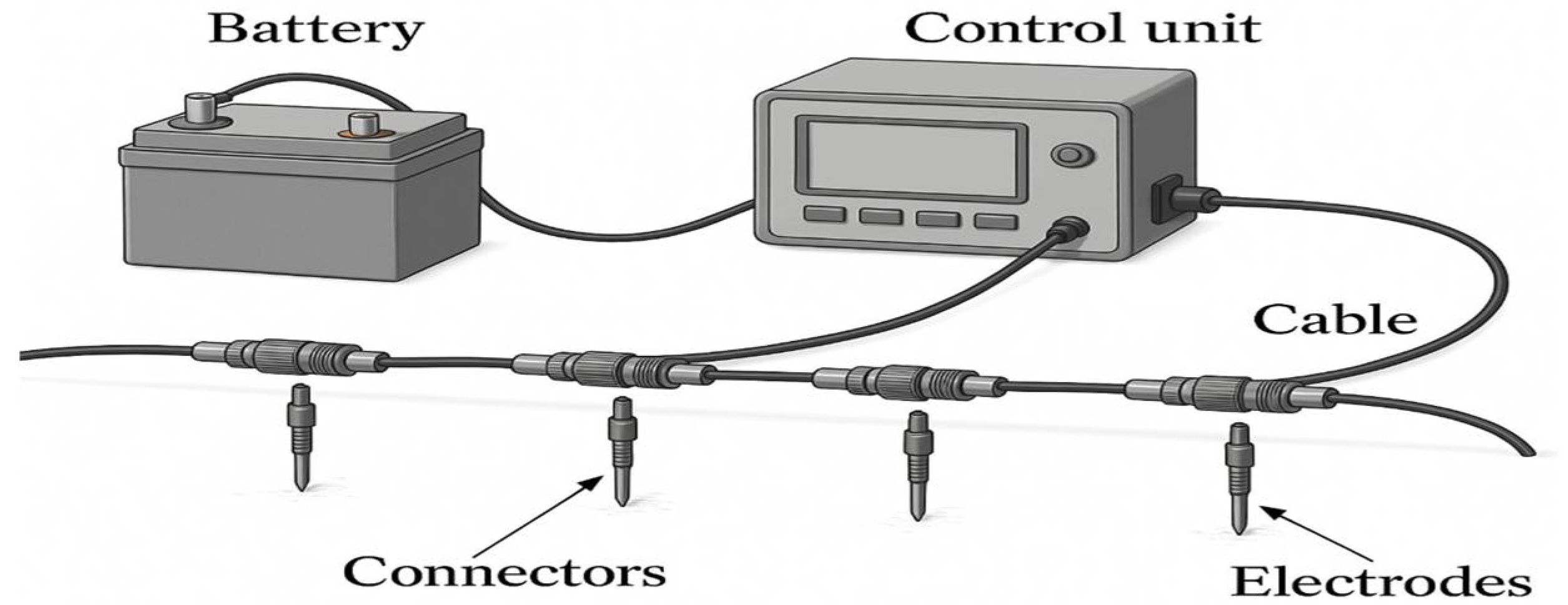

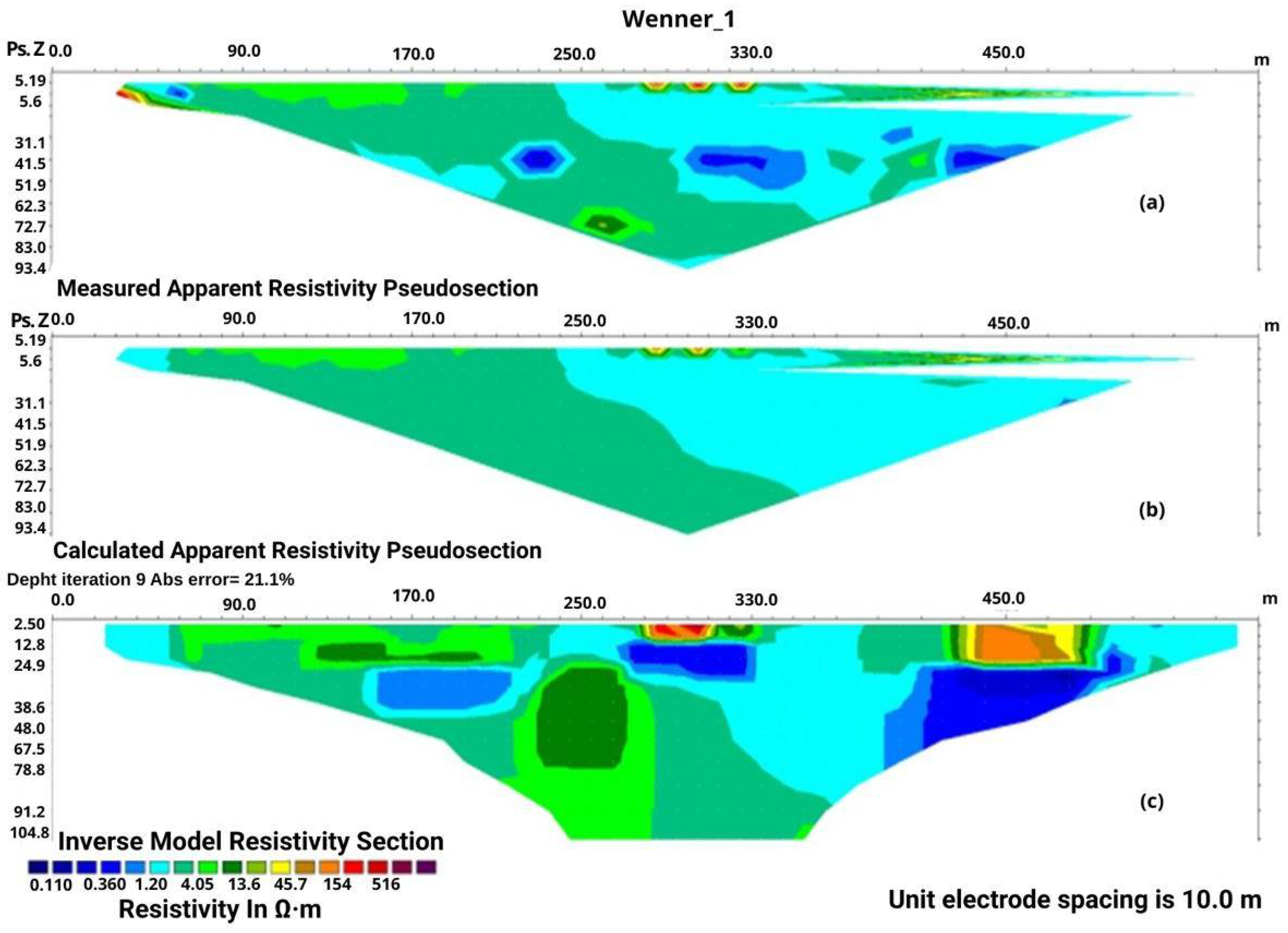


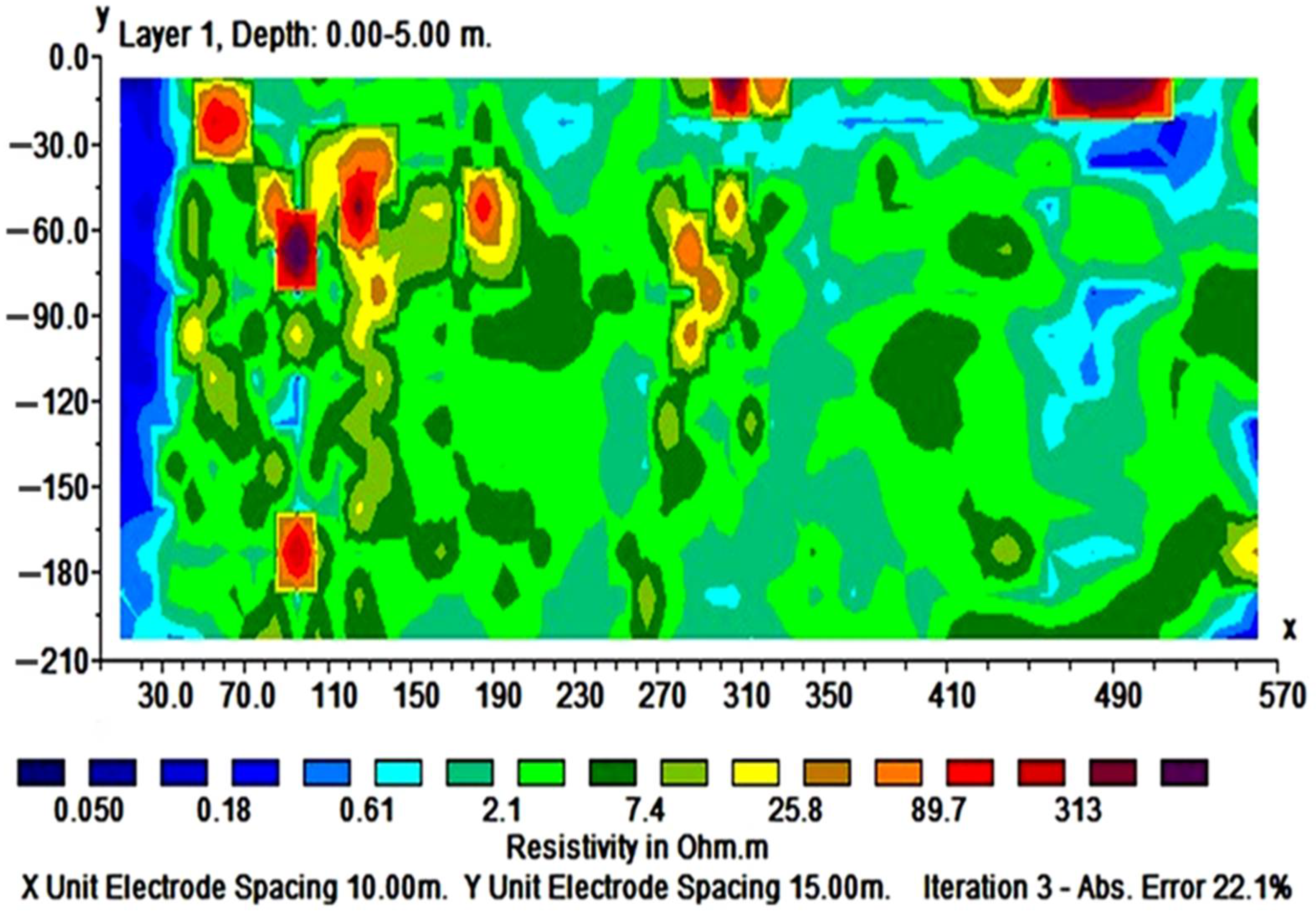
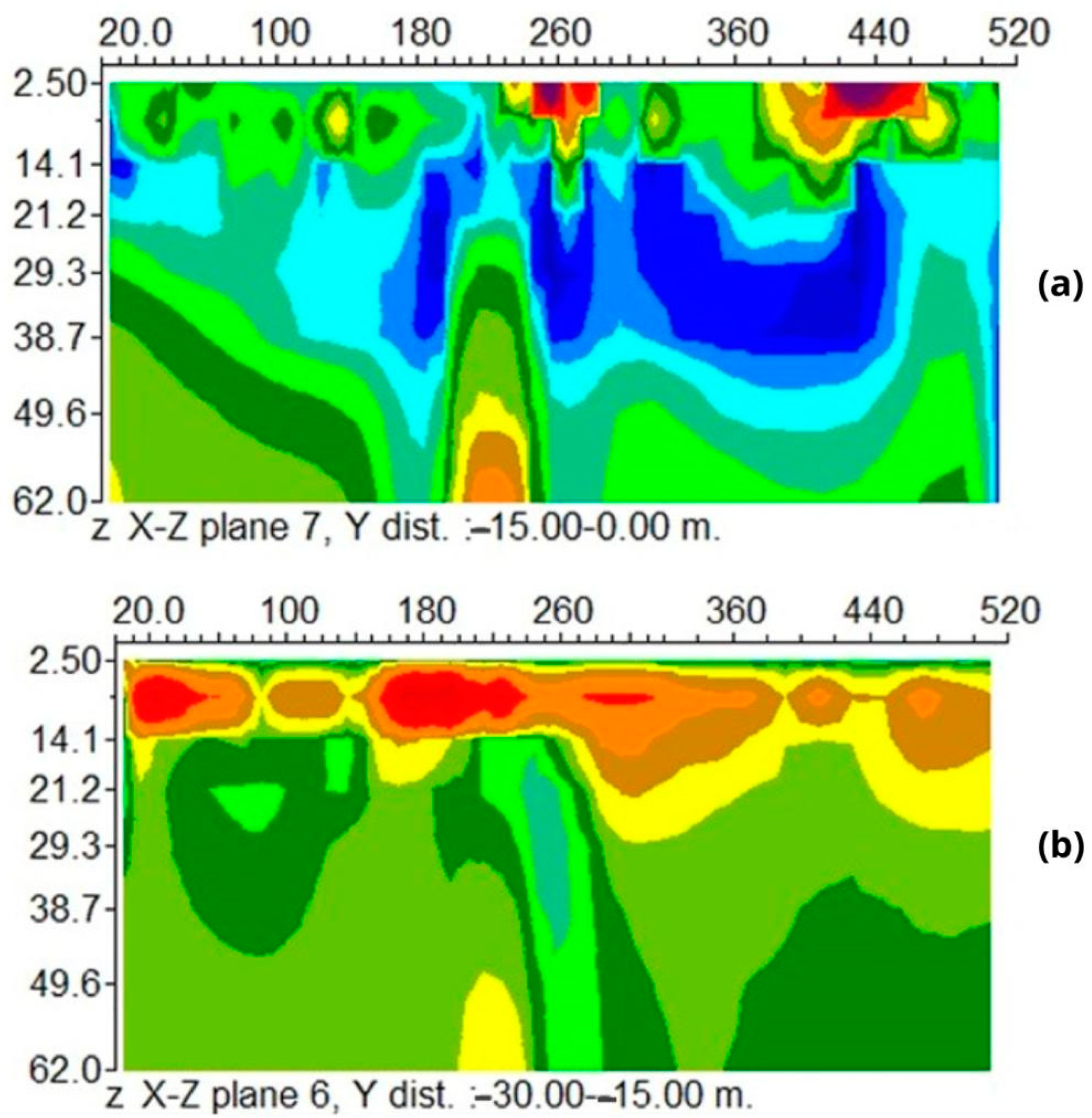
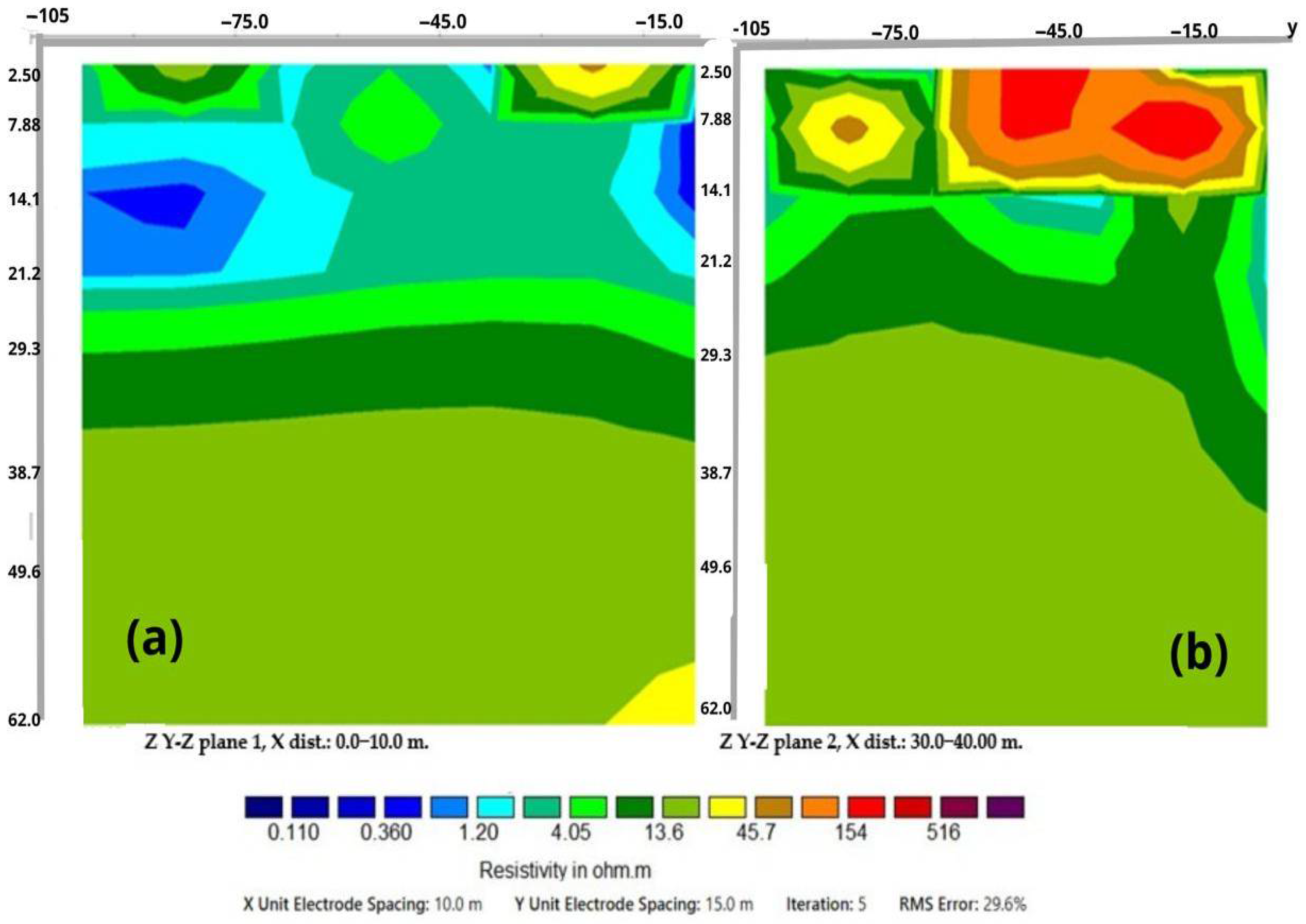
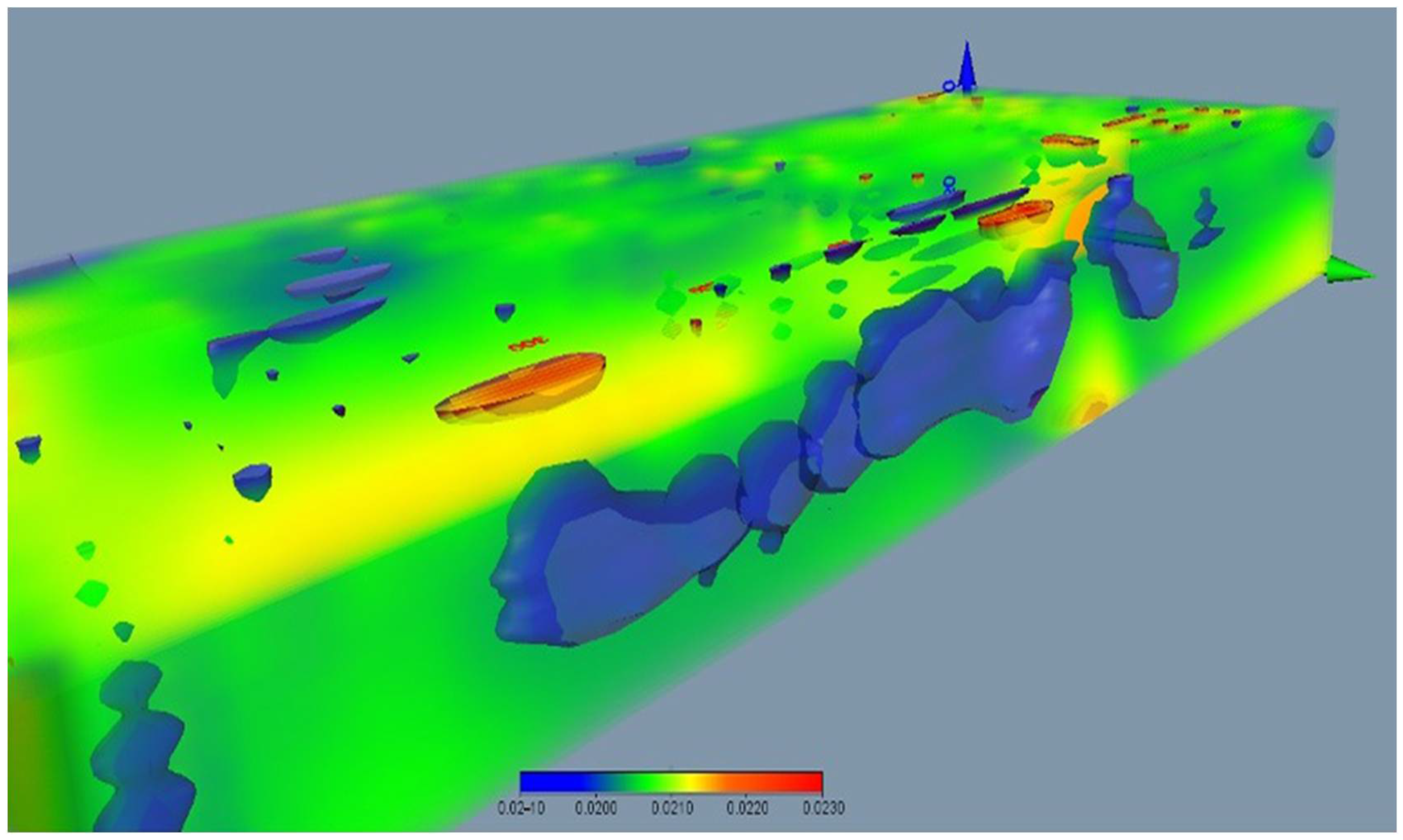

| Geotomography Code | Electrode | North Coordinate (N) | West Coordinate (W) | GPS Elevation (m) |
|---|---|---|---|---|
| No. 1 | 1 | 10°55′48.56″ | 74°55′42.34″ | 69 |
| 47 | 10°55′59.65″ | 74°55′27.61″ | 55 | |
| No. 2 | 1 | 10°55′48.19″ | 74°55′42.03″ | 69 |
| 47 | 10°55′59.28″ | 74°55′27.29″ | 55 | |
| No. 3 | 1 | 10°55′47.82″ | 74°55′41.71″ | 69 |
| 47 | 10°55′58.90″ | 74°55′26.97″ | 55 | |
| No. 4 | 1 | 10°55′47.44″ | 74°55′41.38″ | 68 |
| 47 | 10°55′58.53″ | 74°55′26.65″ | 55 | |
| No. 5 | 1 | 10°55′47.06″ | 74°55′41.07″ | 67 |
| 47 | 10°55′58.17″ | 74°55′26.33″ | 55 | |
| No. 6 | 1 | 10°55′46.68″ | 74°55′40.76″ | 66 |
| 47 | 10°55′57.79″ | 74°55′26.02″ | 55 | |
| No. 7 | 1 | 10°55′46.32″ | 74°55′40.43″ | 65 |
| 47 | 10°55′57.41″ | 74°55′25.69″ | 55 | |
| No. 8 | 1 | 10°55′45.95″ | 74°55′40.11″ | 64 |
| 47 | 10°55′57.05″ | 74°55′25.37″ | 55 | |
| No. 9 | 1 | 10°55′45.58″ | 74°55′39.80″ | 64 |
| 47 | 10°55′56.67″ | 74°55′25.06″ | 54 | |
| No. 10 | 1 | 10°55′45.21″ | 74°55′39.47″ | 64 |
| 47 | 10°55′56.30″ | 74°55′24.73″ | 54 | |
| No. 11 | 1 | 10°55′44.82″ | 74°55′39.14″ | 63 |
| 47 | 10°55′55.93″ | 74°55′24.41″ | 54 | |
| No. 12 | 1 | 10°55′44.47″ | 74°55′38.83″ | 63 |
| 47 | 10°55′55.56″ | 74°55′24.09″ | 53 | |
| No. 13 | 1 | 10°55′44.07″ | 74°55′38.50″ | 63 |
| 47 | 10°55′55.18″ | 74°55′23.77″ | 53 | |
| No. 14 | 1 | 10°55′43.71″ | 74°55′38.19″ | 62 |
| 47 | 10°55′54.81″ | 74°55′23.46″ | 53 | |
| No. 15 | 1 | 10°55′43.34″ | 74°55′37.87″ | 62 |
| 47 | 10°55′54.44″ | 74°55′23.15″ | 53 |
| Line | Wenner (Ω·m) | Dipole–Dipole (Ω·m) | Gradient (Ω·m) |
|---|---|---|---|
| 1 | 36.3 | 75.3 | 126.1 |
| 2 | 117.6 | 46.7 | 152.8 |
| 3 | 107.1 | 92.2 | 68.2 |
| 4 | 101.8 | 56.4 | 55.8 |
| 5 | 128.3 | 53.8 | 90.7 |
| 6 | 110.6 | 25.5 | 103.1 |
| 7 | 31 | 41.8 | 156.6 |
| 8 | 104.3 | 27.1 | 139.8 |
| 9 | 57.5 | 61.8 | 145.5 |
| 10 | 149.5 | 31 | 89.8 |
| 11 | 36.4 | 125.8 | 115 |
| 12 | 46 | 69.9 | 93.7 |
| 13 | 97.8 | 17.1 | 140.8 |
| 14 | 108.4 | 102.8 | 139.8 |
| 15 | 57.2 | 100 | 51.3 |
| Point | Axis a (m) | Axis b (m) | Axis c (m) | Estimated Volume (m3) |
|---|---|---|---|---|
| P1 | 8.0 | 6.0 | 5.0 | 2512 |
| P2 | 8.0 | 6.5 | 5.1 | 2656 |
| P3 | 12.0 | 8.0 | 7.5 | 7065 |
| P4 | 10.0 | 7.0 | 6.0 | 4835 |
| P5 | 9.0 | 6.5 | 5.5 | 3140 |
| Total | – | – | – | 20,208 |
Disclaimer/Publisher’s Note: The statements, opinions and data contained in all publications are solely those of the individual author(s) and contributor(s) and not of MDPI and/or the editor(s). MDPI and/or the editor(s) disclaim responsibility for any injury to people or property resulting from any ideas, methods, instructions or products referred to in the content. |
© 2025 by the authors. Licensee MDPI, Basel, Switzerland. This article is an open access article distributed under the terms and conditions of the Creative Commons Attribution (CC BY) license (https://creativecommons.org/licenses/by/4.0/).
Share and Cite
Trujillo-Romero, O.E.; Restrepo, G.M.; Corrales-Celedon, J.E. Multiscale Geophysical Characterization of Leachate and Gas Plumes in a Tropical Landfill Using Electrical Resistivity Tomography for Environmental Analysis and Diagnosis. Environments 2025, 12, 337. https://doi.org/10.3390/environments12090337
Trujillo-Romero OE, Restrepo GM, Corrales-Celedon JE. Multiscale Geophysical Characterization of Leachate and Gas Plumes in a Tropical Landfill Using Electrical Resistivity Tomography for Environmental Analysis and Diagnosis. Environments. 2025; 12(9):337. https://doi.org/10.3390/environments12090337
Chicago/Turabian StyleTrujillo-Romero, Omar E., Gloria M. Restrepo, and Jorge E. Corrales-Celedon. 2025. "Multiscale Geophysical Characterization of Leachate and Gas Plumes in a Tropical Landfill Using Electrical Resistivity Tomography for Environmental Analysis and Diagnosis" Environments 12, no. 9: 337. https://doi.org/10.3390/environments12090337
APA StyleTrujillo-Romero, O. E., Restrepo, G. M., & Corrales-Celedon, J. E. (2025). Multiscale Geophysical Characterization of Leachate and Gas Plumes in a Tropical Landfill Using Electrical Resistivity Tomography for Environmental Analysis and Diagnosis. Environments, 12(9), 337. https://doi.org/10.3390/environments12090337







